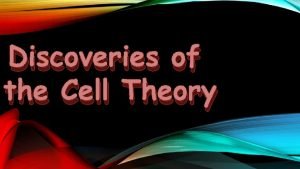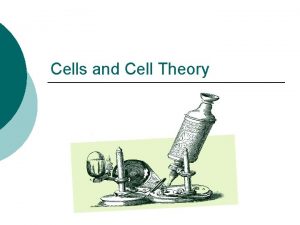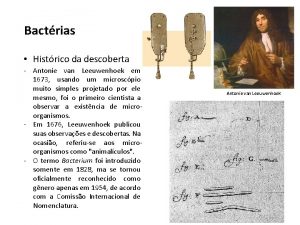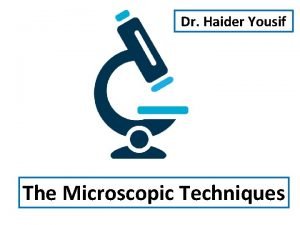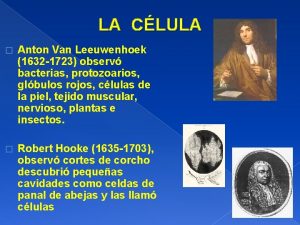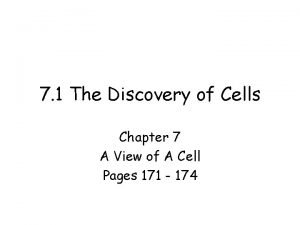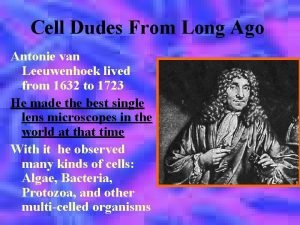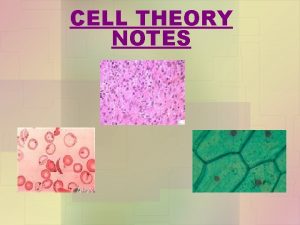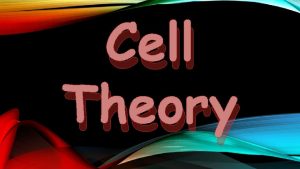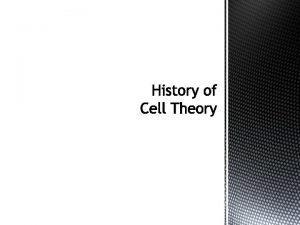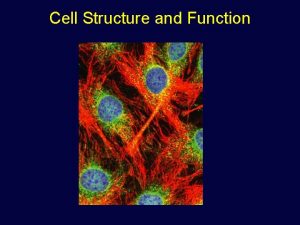CELL THEORY NOTES History Anton Van Leeuwenhoek The











- Slides: 11

CELL THEORY NOTES

History Anton Van Leeuwenhoek • The microscope was invented by Anton Van Leeuwenhoek, a Dutch biologist in the early 1600’s. Leeuwenhoek’s invention allowed him to see tiny living organisms in droplets of water.

History Robert Hook • Became interested in Van Leeuwenhoek’s microscope and used one to look at pieces of cork. • He could see that it was composed of thousands of tiny chambers. He called these chambers “cells” since they reminded him of the small rooms called cells in a monastery. • His discovery was significant since it opened up the study of cells.

Over the next 300 years… • Robert Brown – observed that many cells had a dark structure near the center of the cell, which we now call the nucleus (1833). • Matthias Schleiden – stated that all plants are made of cells. (1838) • Theodor Schwann – discovered that all animals are made of cells too (1839). • Rudolf Virchow – stated that all cells arise from the division of preexisting cells (1855). • Janet Plowe – demonstrated that the cell membrane is a physical structure, not just an interface between two liquids (1931).

The cell theory states: 1. All living things are composed of one or more cells. 2. Cells are the basic units of structure and function in living things. 3. All cells come from preexisting cells.

Why are cells so small? • https: //www. youtube. com/watch? v=t 4 Ts t 9 DZFPI • There are very few large cells • Most are small • Cells must stay small in volume so that they can intake and pump out nutrients

Parts of the Cell • Cell Membrane • Organelle • Nucleus

Difference Between Archaea and Bacteria • Archaea • Lack nucleus • Similar to eukaryotic cells • Cell wall and cell membrane are different • Live where no others can live • Bacteria • Most common prokaryotes • Live everywhere • No nucleus or membrane bound organelles • Strong cell wall

2 Basic Cell Types Prokaryotes Eukaryotes

• Prokaryotes. Cells that DO NOT contain membrane-bound structures • Eukaryotes. Cells that DO contain membrane-bound structures Membrane-bound structures inside eukaryotic cells are called ORGANELLES. Each organelle has a specific function.

Vocabulary • • • Cell membrane Organelle Nucleus Prokaryote Eukaryote
 Anton van leeuwenhoek cell theory
Anton van leeuwenhoek cell theory Antonie van leeuwenhoek cell theory
Antonie van leeuwenhoek cell theory 1673 cell theory
1673 cell theory 1673 anton van leeuwenhoek
1673 anton van leeuwenhoek Anton van leeuwenhoek
Anton van leeuwenhoek Leeuwenhoek
Leeuwenhoek Anton van leeuwenhoek célula
Anton van leeuwenhoek célula Anton van leeuwenhoek teoria de la generacion espontanea
Anton van leeuwenhoek teoria de la generacion espontanea Anton ven leeuwenhoek
Anton ven leeuwenhoek Matthias schleiden accomplishments
Matthias schleiden accomplishments Antonie van leeuwenhoek
Antonie van leeuwenhoek Anton von leeuwenhoek
Anton von leeuwenhoek
